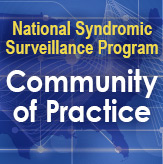Louisiana Takes Action Against Drug Abuse by Sharing Syndromic Data
Injury, Drug Related

Drug abuse—particularly opioid abuse—is a leading public health problem. Tackling drug abuse requires input and action from multiple sectors. In Louisiana, stakeholders engaged in the fight against drug abuse sought a deeper understanding of overdose trends and populations at risk. Public health officials recognized that syndromic surveillance data could help provide these insights. They began sharing syndromic data from emergency department visits related to drug abuse and prescription drug use with organizations and coalitions across the state.
These groups have used the data in a variety of ways. State-based initiatives and coalitions created dashboards of alcohol and opioid abuse trends. The governor’s office put syndromic data to work to evaluate current policies and shape new ones. Law enforcement and other groups developed innovative ideas for overdose response. School and community-based organizations used a data repository to support substance abuse reduction programs.
Syndromic data now play a pivotal role in monitoring and responding to drug abuse in Louisiana as organizations continue to use and share data as part of their program activities. Funding from the National Syndromic Surveillance Program supports the use of syndromic surveillance in improving the nation’s public health.
Public Health Problem
Louisiana, like other states, grapples with widespread drug abuse. CDC’s Drug Overdose Death Data show Louisiana had a statistically significant 14.7% increase in its drug overdose death rate from 2015–2016. As early as 2013, the Louisiana Office of Public Health, Infectious Disease Epidemiology section (IDEpi), began receiving requests for drug abuse data from the governor’s office and community-based organizations for a deeper understanding of overdose trends and populations at greatest risk. The IDEpi team, which conducts the state’s syndromic surveillance (SyS), recognized that to engage communities and organizations in the fight against drug abuse, syndromic data should be widely shared.
Actions Taken
IDEpi began by sharing the percentage of emergency department visits related to substance abuse with the State Epidemiology Workgroup, an initiative of the governor’s office, and with the Greater New Orleans Drug Demand Reduction Coalition. Both organizations created dashboards to summarize trends in alcohol and drug abuse and, specifically, in opioid abuse. The governor’s office used syndromic data to shape policies on substance abuse and to evaluate current policies. IDEpi shared syndromic data on prescription drug use by gender, race, ethnicity, and symptom information (collected from chief complaint and diagnosis fields). Data were put into a repository that schools and community-based organizations could use to support substance abuse reduction programs. Syndromic data were used to develop innovative ways that local law enforcement and other groups could respond to drug overdoses. Also, syndromic data were used to secure the Strategic Prevention Framework for Prescription Drugs grant and the State Targeted Response to the Opioid Crisis grant from the Substance Abuse and Mental Health Services Administration (SAMHSA) as well as the Data Driven Prevention Initiative grant and Enhanced State Opioid Overdose Surveillance grant from the CDC. Grant funding enable more staff to identify drug abuse trends and compile drug abuse data.
Outcome
Syndromic surveillance is an excellent source of data with many public health applications. It is flexible and can be adapted to the needs of different communities, which is essential because drug abuse trends and characteristics can vary across communities. By sharing syndromic data with others who fight substance abuse, Louisiana enhanced state awareness of trends in opioid abuse. Academia and organizations that study and present drug abuse trends use these data to gain funding to implement new prevention programs. Some of these organizations integrate drug abuse data into dashboards for broader audiences, whereas others use SyS data to demonstrate the need for funding by presenting the burden of disease. These organizations will continue to use SyS data as a component of various program activities or grant deliverables. Ultimately, SyS data play a pivotal role in Louisiana’s surveillance of and response to drug abuse.
Lessons Learned
Share syndromic data with organizations, academia, law enforcement, and others already engaged in the fight against drug abuse.
Use syndromic data to:
- Help secure grants and other funding to implement new programs.
- Identify at-risk populations and demonstrate the prevalence of substance abuse.
- Develop dashboards and data repositories for organizations that respond to drug overdoses or support substance abuse reduction programs.
- Inform new policy and evaluate current policies.
Contacts
Jenna Iberg Johnson
Infectious Disease Epidemiology Section
Louisiana Office of Public Health
www.dhh.la.gov/leeds
Office of Public Health Data, Surveillance, and Technology
Division of Health Informatics and Surveillance
www.cdc.gov/nssp
This success story shows how NSSP
- Improves Data Representativeness
- Improves Data Quality, Timeliness, and Use
- Strengthens Syndromic Surveillance Practice
- Informs Public Health Action or Response
The findings and outcomes described in this syndromic success story are those of the authors and do not necessarily represent the official position of the National Syndromic Surveillance Program or the Centers for Disease Control and Prevention.
